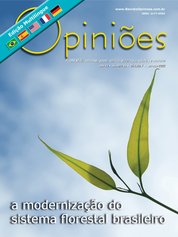Guilherme Oguri
Coordenador do PCMAF do IPEF
OpCP69
Uma reflexão sobre a modernização florestal
Em 2016, em minha primeira reunião como coordenador junto às 12 empresas filiadas ao Programa Cooperativo sobre Mecanização e Automação Florestal (PCMAF), pertencente ao Instituto de Pesquisas e Estudos Florestais (IPEF), a principal pauta era a definição das grandes linhas de pesquisa em que o programa atuaria a partir daquele dia.
A decisão foi unânime: focar na mecanização dos processos silviculturais. Consequentemente, a colheita e o transporte não estariam entre as grandes linhas de pesquisa. A justificativa para essa decisão era clara, uma vez que a colheita e o transporte estavam – e ainda estão – em um nível de mecanização muito superior às atividades silviculturais de plantio e irrigação, por exemplo. Desde então, o programa vem acompanhando de perto os desenvolvimentos tecnológicos e as tendências de mercado, principalmente, dessas duas atividades e, mais atualmente, da automação de viveiros.
 Na edição número 62 da Revista Opiniões, em coautoria com o Prof. Saulo Guerra (líder científico do PCMAF/IPEF e docente da Unesp), escrevemos sobre a evolução dos sistemas de irrigação pós-plantio existentes no Brasil. Essa edição foi publicada no final de 2020, e, relendo a matéria, notei que não houve muito avanço tecnológico até os dias de hoje. Arrisco a dizer, inclusive, que não surgiram novos equipamentos para a mecanização da irrigação pós-plantio.
Na edição número 62 da Revista Opiniões, em coautoria com o Prof. Saulo Guerra (líder científico do PCMAF/IPEF e docente da Unesp), escrevemos sobre a evolução dos sistemas de irrigação pós-plantio existentes no Brasil. Essa edição foi publicada no final de 2020, e, relendo a matéria, notei que não houve muito avanço tecnológico até os dias de hoje. Arrisco a dizer, inclusive, que não surgiram novos equipamentos para a mecanização da irrigação pós-plantio.Obviamente, não conheço todos os desenvolvimentos em curso, porém, entre momentos de reuniões, coffebreaks de eventos e visitas às empresas, os comentários de colegas corroboram a minha percepção. Questiono o motivo, ou motivos, de não vermos novas ações em busca da mecanização dessa operação tão importante e recorrente quando comparada com a mecanização do plantio, que é mais complexa, e temos diversas novas ações.
Será que estamos focando no plantio e “deixando de lado” a irrigação? Será que está faltando investimento para reconhecimento da muda (visão computacional) com o objetivo de automatizar a irrigação? Enfim, deixo a reflexão.
Por outro lado, presenciamos o momento com a maior quantidade de modelos de plantadoras mecanizadas sendo desenvolvidas e algumas já comercializadas. Novamente, fazendo uma comparação com um artigo escrito para a Revista Opiniões, dessa vez, uma publicação sobre a pesquisa e o desenvolvimento do plantio florestal escrita pelo Prof. Saulo e o Sr. José Carlos de Almeida (Diretor da JFI), na edição número 57 (set-nov/2019), praticamente todos os equipamentos citados pertenciam ao mesmo fabricante.
Além dos fabricantes nacionais, hoje vemos grandes players internacionais investindo em plantadoras e, até mesmo, adquirindo empresas especializadas em plantio mecanizado. Recordando que há 10 anos tinha praticamente uma ou duas empresas, hoje consigo contar pelo menos 9 fabricantes investindo em plantadoras.
Como sempre discutimos no PCMAF, será muito difícil termos um único modelo de plantadora que consiga operar de forma satisfatória e em ritmo operacional, independente da condição da área (tipo de solo, relevo, declividade, tipo de manejo etc.). Alguns modelos conseguem se destacar em áreas menos “exigentes”, como áreas planas e de implantação, o que permite realizar o plantio de até 3 mudas simultaneamente. Outros modelos se mostram mais eficientes em áreas declivosas, principalmente os cabeçotes de plantio instalados em escavadoras hidráulicas.
Temos notado que, independentemente do fabricante e do modelo, existe uma variável que possui alta influência no desempenho do plantio mecanizado e que não pode ser ignorada, que é a qualidade da muda. Na verdade, não existe apenas uma variável e sim diversas variáveis que influenciam a sua qualidade, como a altura, a tortuosidade, a qualidade do substrato, entre outros.
Justamente devido a essa influência da muda no plantio mecanizado, fomentamos uma discussão em torno da padronização da qualidade de mudas, ou seja, como melhorar os processos de produção das mudas que serão utilizadas em plantios mecanizados? O modelo de produção de muda atual vai atender à demanda de qualidade dos sistemas mecanizados?
Naquela reunião que citei no início do texto, foi estipulada uma linha de pesquisa sobre automação de viveiros, porém poucas ações foram feitas, até um passado recente. Por isso, o IPEF iniciou um projeto visando fomentar o desenvolvimento de novos equipamentos que permitam a sua introdução em viveiros estabelecidos, sem que haja um grande distúrbio no ritmo operacional atual. Por outro lado, há máquinas adaptadas de outras culturas com alto nível de automação que utilizam inteligência artificial e visão computacional para os processos de seleção de mudas e estaqueamento, por exemplo.
Acreditamos que esses equipamentos necessitam de uma atenção especial ao longo do seu desenvolvimento e que é necessária a participação de profissionais de diversas áreas do conhecimento, dada a sua complexidade tecnológica. Essas ações visam dar o foco necessário que os viveiros florestais merecem, uma vez que é a fonte do nosso recurso florestal.
Acredito que de nada adiantará discutirmos sobre plantio mecanizado, irrigação automática, drones, visão computacional e inteligência artificial aplicada aos plantios florestais se não olharmos com carinho para a evolução dos nossos viveiros. Para concluir, tenho a percepção de que a modernização do sistema florestal brasileiro vai muito além de máquinas e automações. Temos, nas universidades, disciplinas que “modernizam” os futuros engenheiros florestais? Estamos atualizando os profissionais no mesmo ritmo em que atualizamos as nossas máquinas? Em suma, precisamos refletir e agir.




